Angel Cantillo, Sebastián Raveau, Juan Carlos Muñoz
Abstract
Transantiago, the public transport system of Santiago, Chile, has one of the highest fare evasion rates registered worldwide. The official statistics for late 2019 indicated that the evasion rate in bus legs was 26.6% while in metro it was almost 0%. This is a relevant issue due to the impacts of fare evasion on finances and quality of service, as budget constraints put pressure on the transit system. Analysing and understanding fare evasion should be the starting point for proposing solutions that could reduce it. Therefore, in this research we seek to answer the question of who are the evaders, when and where evasion happens and how is the fare evaded on public transport. To answer these questions, extensive data was gathered onboard buses of Transantiago for five full days (19 h a day) of operation, including weekdays and weekend. A total of 10,559 individual records were collected. The information considers age and gender of travellers, and fare evasion was measured in zones of Santiago that are characterised by very different economic conditions. Records also differ in terms of bus occupancy, presence of turnstiles in the buses, and types of stops (with and without off-board payment). Based on the collected information, a Binomial Logit model was calibrated to understand and explain fare evasion, quantifying the effect of different types of explanatory variables. Results show that fare evasion is higher for young men, evening and night periods, low-income neighbourhoods, crowded buses without turnstiles, bus stops without off-board payment and weak accessibility to metro stations and fare vending machines. The model does not only allows the identification of these trends, but is also able to quantify them. Based on the results, potential proposed solutions to tackle evasion are discussed.
